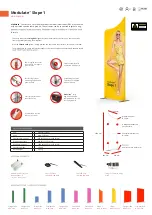
Centripetal Force Accessory
Model No. ME-8089
8
®
Setup
Follow the equipment setup instructions on pages
4-7 of this manual. Use the appropriate
DataStudio setup file on the experiment disk or
the DataStudio setup instructions in Appendix A.
Experiment Tips
a)
To add mass to the “sliding mass” holder, lay
the components over the attachment screw in
the following order: a) cable b) mass and c) nut
to tighten.
Note:
Do not place the mass underneath the
cable, as this will interfere with a proper measurement.
b)
Place an equal amount of mass on the “fixed mass” and “sliding mass” holders.
c)
Be sure to place the “fixed mass” at the same radius as the “sliding mass” to ensure
balancing of the unit as it rotates.
d)
To add the “sliding mass,” lay the components over the attachment screw in the following
order: a) cable b) mass and c) nut and d) thumbscrews to tighten.
e)
The velocity of the “sliding mass” can be measured as an angular velocity. In DataStudio,
use a Graph display to monitor the velocity of the rotating mass. If velocity readings do
not appear, check your photogate connection and DataStudio setup (See Appendix A).
f)
To vary the radius, adjust the position of the Force Sensor (See Figure 1-3.)
g)
If the rotating arm does not move, there may be too much friction in the cable or the pulley
and turning rod may be too tight. Move the Force Sensor down to loosen the cable or
adjust the turning rod.
Experiment Procedure
1.
Place 100 g mass on each mass holder and secure with the thumbscrews.
2.
Adjust the position of the fixed and sliding mass to about 20 cm (Note: The maximum
radius is 22 cm. To adjust the position, pull outward on the mass to tighten the wire.)
3.
Set up your experiment in DataStudio. Set the smart pulley on angular speed (rad/sec) and
create two equations: Force= -smooth (10, F) and speed squared=V^2. Set the sample rate
to 10 Hz. (For more information, see Appendix A.)
4.
With the knurled shaft, spin the rotating platform (by hand) to about 6 radians/second (1 or
2 Hz) and let go.
Figure 1-1: Spinning the Platform






























